|
Miscellany |
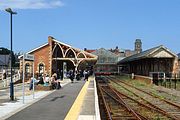 |
Aberystwyth station pictured on a gloriously sunny 5 August 2002. This trainless scene gives an uninterrupted view of the station buildings and ornate platform awnings. The imposing station building was constructed in 1925 by the Great Western Railway. Originally with five platform faces, the facilities at the station have contracted through the years, and as can be seen from the single line of non rusty track, is now down to a single platform. |
|
|
The Aberystwyth Cliff Railway, pictured on 5 August 2002. This 4 ft 10 in funicular opened in 1896, ascending from near sea level at the north end of the town, to near the top of Constitution Hill, ascending approximately 430 feet in its 778 ft length. Three bridge cross the line, all of which can be seen in this view. The two cars were originally operated using the water balance system, but the line was electrified in 1921. This picture is taken half way up the incline, where the tracks separate sufficiently for the two cars to pass each other. |
||
 |
Ascott-under-Wychwood station, pictured during a brief burst of sunshine on 6 July 1978. This historic view shows the track in the now lifted small goods yard, complete with ground signal. Some of the rail chairs were dated 1906. Also visible in the background is the marooned up platform, which became useless after the singling of the line in 1971. This was subsequently removed, and in recent years, with the reinstatement of the double track, a modern replacement has been provided. This slide is from my very first 35mm colour transparency film. Unfortunately this was a roll of Perutz C18, a film with quite unbelievably coarse grain (considering it was only ISO 50). Also, unlike the Kodachrome 64 which I used thereafter, time has not been kind to the images. Whilst the Kodachromes are as good as the day they arrived back from Hemel Hempstead, the Perutz has colour shifted markedly (corrected here). |
|
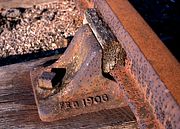 |
A Great Western Railway cast iron chair dated Feb 1906 still in situ in the goods yard at Ascott-under-Wychwood on 6 June 1979. The small yard, which by this time was only used for stabling the occasional track machine, had obviously not seen any maintenance for a long time. Just look at the amount of rust on the railhead, and the terrible condition of the wooden key! |
|
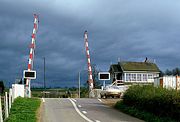 |
Ascott-under-Wychwood level crossing, pictured in some extremely dramatic lighting on 10 May 1986. The barriers and the adjacent signal box are illuminated by the evening sun, while to the south the landscape in under some very dark clouds. Since this picture was taken, the barriers have been replaced with a slightly modified design, and the signal box has acquired new windows. Also, it's a virtual certainty that the signalman's Morris Marina has long since gone to the scrapyard! |
|
 |
A trainless view of Ascott-under-Wychwood station, photographed on 6 October 2016. This clearly shows the new up platform, which was added in 2011, when the line was redoubled. Note the reproduction GWR seat, and the normal basic small station features: us shelter' waiting room, electronic information point, and disabled friendly access ramps. The station was originally opened by the Oxford, Worcester & Wolverhampton Railway in 1853. It was called simply 'Ascott' until 1880. |
|
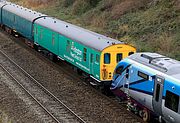 |
Arlington Fleet Group translator vehicle 68504 (formerly Gatwick Express GLV 9105), pictured in the consist of the 5Q32 10:24 Portbury Automotive Terminal to Crewe ECS at Badgeworth on 4 December 2018. This was the delivery run of Spanish built EMU 397003. In addition to the two translator vehicles, there were four barrier vehicles acting as brake runners. Note the temporary brake pipe being fed in through the side window of the EMU. It clearly needs these brake vehicles, as the rusty brake disc on the EMU proves that its brakes are inoperative. |
|
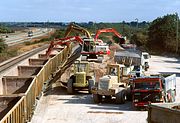 |
Synchronised excavators at Banbury Road Stone Terminal on 15 September 1990. Three machines get busy unloading a stone train, which had been brought to the site by 56036, and also loading up lorries, which were taking the stone off site. The stone terminal has now been repositioned further back, as Oxford Parkway station now occupies this site. |
|
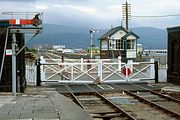 |
Vintage GWR infrastructure at Barmouth, pictured on a very overcast 18 June 1982. The semaphore signals, level crossing gates and signal box have all now been swept away. However, there is a happy ending, as the signal box has found a new home at Glyndyfrdwy, on the Llangollen Railway. |
|
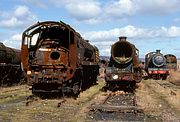 |
The unmistakable sight of steam locomotives rusting away in Dai Woodham's scrapyard at Barry. I had visited the yard in 1973, and took some very poor B&W Instamatic photos, but it wasn't until 1987, when the number of locos in the yard had reduced considerably, that I returned to the yard armed with a proper camera and some Kodachrome 64. This is the scene on 25 March 1987, with Southern Railway rebuilt West Country Class 4-6-2 34046 Braunton prominent in the foreground, next to LMS 8F 2-8-0 48173. In the distance, between these two, is Merchant Navy 4-6-2 35011 General Steam Navigation. On the left is Stanier Black Five 4-6-0 44901, and completing this diverse line up, the two locos on the right are GWR 42xx 2-8-0Ts 4253 & 5227. |
|
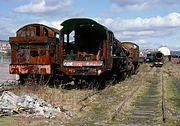 |
Dai Woodham's scrapyard at Barry, pictured on 25 March 1987. The tenderless loco in the centre of the picture is LMS Black Five 4-6-0 44901. It is surrounded by GWR 2-6-2 tanks, with 'Small Prairie' 45xx 2-6-2T 5539 alongside, and 'Large Prairie' 5101 2-6-2T 4115 in front. In the background is Southern Merchant Navy 4-6-2 35011 General Steam Navigation. |
|
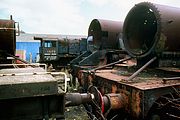 |
A melancholy scene at Dai Woodham's scrapyard at Barry, photographed on 25 March 1987. LMS Class 8F 2-8-0 48173 is marked up for sale to the Bitton Railway 8F Group. In the foreground is GWR 45xx 2-6-2T 5539, with LMS 'Black Five' 4-6-0 44901 just behind. This was in particularly poor condition (note the sections cut out of the smokebox), and although saved from the yard, has still not yet been restored. |
|
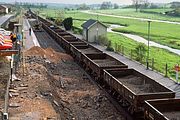 |
Bedwyn station pictured on 7 May 1983, the day after a stone train derailed whist passing through, partly demolishing the platform. The errant MSV open wagon that caused the accident can be seen dumped in the old bay platform on the left. The rails have already been removed, and work is about to start to clear up the mess, with a train of Grampus wagons waiting to receive the spoil. |
|
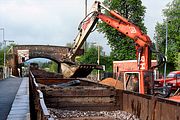 |
Clearance work at Bedwyn station on 7 May 1983, the day after a stone train derailed, damaged the up line. With both lines closed, a digger gets to work loading a train of Grampus wagons with ballast and damaged sleepers. |
|
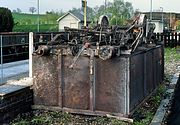 |
The damaged MSV wagon that caused the derailment at Bedwyn station on 6 May 1983, pictured the following day unceremoniously dumped upside down in the old bay platform. Note that one axle has been completely ripped away in the accident. |
|
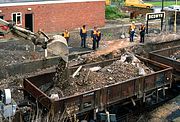 |
Grampus wagon DB991769 receives another shovel full of ballast, as work proceeds to clear the site of a stone train derailment at Bedwyn station on 7 May 1983. The accident, which happened the previous day, was caused when an old MSV open wagon became derailed whilst passing through the station, damaging both the track and the platform. |
|
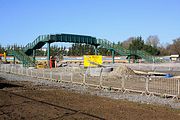 |
As part of the work to construct a new chord linking the Oxford to Bletchley and Chiltern Lines at Bicester, a new footbridge has had to be provided to preserve a public right of way that predates both the railways. This is the view of the still to be opened bridge on the new line between Bicester South Junction and Gavray Junction, pictured on 19 January 2015. |
|
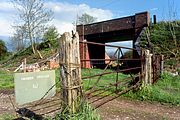 |
Very early preservation days at Blunsdon, on what would later become the Swindon & Cricklade Railway. This picture, which was taken on 27 May 1979, shows the roadbridge at Tadpole Lane, Blunsdon, which was then in open country, rather than on the edge of Swindon's urban sprawl, as now. The only indication of the Swindon & Cricklade Railway Society's interest in the site, is the rather crude handmade notice hanging from the barbed wire. The original Blunsdon station opened in 1895, one of the last stations to be opened by the Midland & South Western Junction Railway. The GWR's ambivalence towards its former competitor is possibly why it closed to passengers in 1924, shortly after the grouping, although it remained open to goods traffic until 1937. |
|
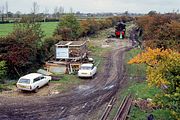 |
The Swindon & Cricklade Railway's Blunsdon site, pictured in the very early days of the society's activities, on 25 October 1980. Some rails have arrived, but as yet no track has been laid. Unfortunately I can find no record of the identity of the loco seen in the background. Any information would be gratefully received. As you expect, both the cars seen here are no longer on the road. The Ford Escort 1.1 litre estate only managed a life of nine years, but the Rover 3.5 litre did slightly better with a 15 year lifespan. I have been told that the Escort previously belonged to a TV rental company, the main clue being the pair of clips below the rear window, used for fixing an advertising sign. |
|
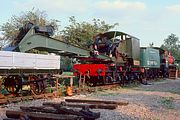 |
One of the first items of rolling stock to arrive at the Swindon & Cricklade's site at Blunsdon was this Thomas Smith & Sons Steam Crane. It is seen here on the preservation site's first section of track on 23 August 1981, along with the unrestored GWR Hall Class 4-6-0 7903 Foremarke Hall. The crane, which was built at Rodley, near Leeds, seems largely complete, apart from its cables, and has obviously just received a repaint. |
|
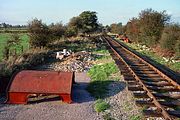 |
The Swindon & Cricklade Railway's site at Blunsdon, pictured on 21 October 1983. The first tentative length of track has been laid, and various items of building materials are lying around. In the foreground is what appears to be a GWR 45xx 2-6-2T cab roof. It would be another two years before the society was able to run its first trains. |
|
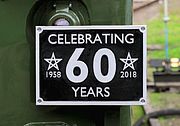 |
The 'Celebrating 60 Years 1958 - 2018' headband, carried by D5314, on the Caledonian Railway, pictured at Brechin on 1 September 2018. Although this applies to the Class 26 fleet, it could equally well apply to me! I was born in 1958, but to be strictly accurate D5314, which may well have been completed in 1958, did not enter service until January 1959. |
|
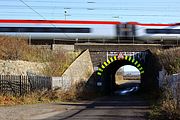 |
Bridego Bridge, on the West Coast Mainline between Leighton Buzzard and Cheddington, pictured on 25 November 2016. This was the location that was used on 8 August 1963 to transfer the high value mailbags from the TPO train to the waiting lorry, during the Great Train Robbery. The train had been stopped a little further up the line at Sears Crossing, and then driven to this spot under the direction of the robbers. It has now probably become the most photographed rail underbridge in the UK! This picture was taken at 1/60sec to deliberately blur the passing Pendolino. |
|
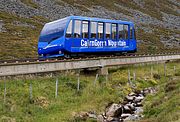 |
The Cairngorm Mountain Railway, the only funicular railway in Scotland, opened in 2001. It climbs 1,509 feet up the northern slope of Cairn Gorm, and is used extensively during the winters months by skiers. The 2 metre (6 ft 6¾ in) gauge line works on the permanently connected cable system, with one car being hauled to the top, while the other descends. The two cars pass in a short section of double track half way up the incline. Carriage No.2 Cairn approaches Base station, after descending with the 16:10 departure from Ptarmigan station on 30 August 2018. |
|
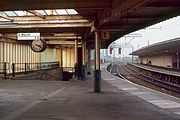 |
Carnforth station is world famous as one of the settings used in the 1945 film Brief Encounter. The clock above the subway steps features prominently in the film, which starred Celia Johnson and Trevor Howard. Although the station has recently been refurbished, when I visited on 17 July 1999, it was a dismal, windswept and dilapidated place. |
|
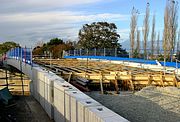 |
As part of the Great Western Mainline electrification programme, numerous road overbridges are having to be rebuilt to increase the headroom for the overhead wires. One of these is the A417 bridge at Challow. It was closed to traffic on 6 September 2014, and the old steel bridge was removed during a full line possession. This view, taken on 1 November 2014 from the temporary footbridge, shows the new roadway beams in place. Presumably the new structure will be mostly concrete, and not require much upkeep. Just as well, as Network Rail have a very poor record when it comes to such simple things as painting metal structures. The previous bridge at Challow had got into a very poor state, due to lack of maintenance. |
|
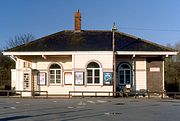 |
Charlbury station is famous for its original Brunel designed wooden chalet style station building, which managed to survive the GWR rebuilding of nearby stations such as Kingham and Moreton-in-Marsh. The 1853 building was restored in 1979, and is now Grade II listed. This is the view from the car park on 10 April 1987, before parked cars made the view more difficult. This also shows the station in a slightly lighter colour than at present (or else more faded), and even includes a matching cream coloured telephone box. |
|
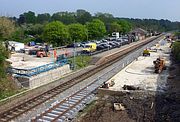 |
After spending the whole of its 150+ years life without a footbridge, Charlbury station finally acquired one in 2011. Admittedly after the line was singled in 1971 it didn't need one, but the reinstatement of the down platform made it essential. The new platform is nearly complete, and work is underway on the footbridge foundations in this 21 April 2011 view. |
|
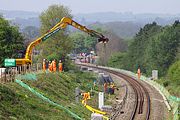 |
A JCB lifts another load of wire cages into position near Charlbury on 21 April 2011, in connection of the redoubling of the Cotswold Line. This location, near Cornbury Park, will be where the newly doubled track will end, with the single track retained from here to Wolvercote Junction. |
|
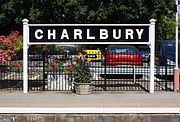 |
Charlbury station is full of character, and retains many ex Great Western Railway features, including a pair of traditional large wooden name boards, or running in boards, as they are more correctly called. Dahlias and rambling roses complement the scene on 19 July 2013, although brought thoroughly up to date by the car park in the background! |
|
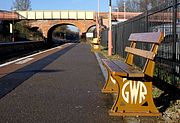 |
Like most stations on the Cotswold Line, Charlbury's platforms have been provided with a number of replica GWR seats, which certainly adds to the period charm of the station. Less picturesque, but just as useful, is the new footbridge, which can be seen in the background here. In steam days a barrow crossing was considered sufficient to access the down platform, but when this was reinstated in 2011, this new footbridge was provided. |
|
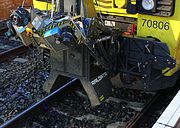 |
A close up view of the Fugro Raildata Rail Infrastructure Alignment Acquisition System mounted on the front of 70806, pictured while the locomotive waited in Charlbury station on 30 November 2016, as it worked the 0C08 07:22 Westbury to Westbury (via Worcester Shrub Hill) survey working. Note the purple laser light shining on the track. |
|
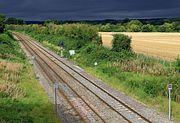 |
The perils of railway photography! Absolutely stunning light, but no train. This is the view from the bridge next to Charlbury station, taken while I was waiting for the 1Z22 08:20 Tyseley to Bristol High Level Siding Network Rail test train on 9 September 2020. Naturally this fantastic light had long gone by the time that came! This trainless view does clearly show the myriad of stop signs for different lengths of train using either of Charlbury's platforms. |
|
 |
The one colourful addition to GWR's drab dark green IET fleet. 800008's 'Pride Stripes', photographed while the unit was standing at Charlbury station on 3 July 2021 with the 1W14 09:50 Paddington to Hereford service. This view also shows the yaw damper bolster, the component that caused so much trouble when fatigue cracks were discovered in some of the fleet. |
|
 |
This certainly livens up a dull green GWR Class 802! Paddington Bear adorns the side of vehicle 838106 of unit 802106. Photographed while the 1P34 15:18 Worcester Foregate Street to Paddington train called at Charlbury station on 3 March 2025. |
|
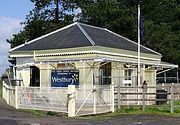 |
The beautifully restored Cheltenham Racecourse station building is picture here on 3 May 2004. This marks the southern limit of the Gloucestershire Warwickshire Railway, although the trackbed carries on towards Cheltenham through Hunting Butts Tunnel. The platforms are in a deep tree lined cutting, with this building at road level at the top of the cutting. The building is a rare survival of what is effectively a Great Western Railway prefabricated design. Even a Portakabin looked so much better in Victorian times! |
|
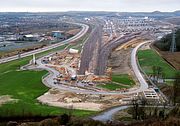 |
The partially built Cheriton Channel Tunnel Terminal, viewed from the nearby Castle Hill on 21 December 1991. Only some of the tracks have so far been installed. The two halves of the tunnel had met under the channel the previous year, but it would be 1994 before it officially opened. The rather empty M20 motorway is on the left. |
|
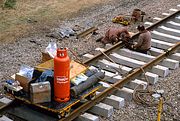 |
Preparations for thermit welding at Chilson on 13 April 1986, during a Sunday Cotswold Line engineering possession. With propane cylinders and tools loaded onto a trolley (along with the workman's lunch!), a couple of workers assemble a mould around the joint. The welding crucible can be seen on the ballast behind them. Note the complete absence of any hi-visibility clothing. Today the men would be wearing orange head to toe! |
|
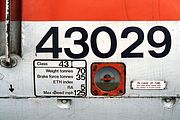 |
HST power car 43029's bodyside number and data panel, pictured while the 1A49 12:15 Bristol Temple Meads to Paddington service was stopped in Chippenham station on 27 October 1992. It is slightly ironic that the fire handle aperture is half full of water! |
|
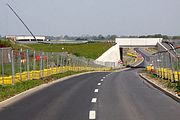 |
Two new rail projects in one picture at Calvert. In the foreground the newly realigned road from Calvert passes underneath the reconstructed East West Rail line, while in the background a crane marks the site of the HS2 project, crossing the East West Rail line at angle. When the East West Rail line was a single track freight line, the road in the foreground was a few yards to the right of this picture, and crossed the line by an overbridge. 11 May 2024. |
|
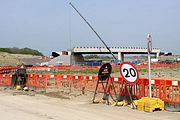 |
The Perry Hill Overbridge, near Calvert, under construction on 11 May 2024. This bridge on the new HS2 route will carry a minor road over the high speed line. At this point the new line is very close to the course of the former Great Central Railway, which closed in 1966. |
|
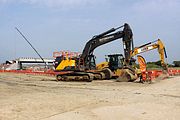 |
Lots of diesel is required to build a so called environmentally friendly electric railway! A pair of excavators stand next to the Perry Hill Overbridge, near Calvert, on 11 May 2024. Admittedly the Volvo in the foreground is a hybrid vehicle, but not so the Caterpillar behind it, or many of the other thousands of items of plant used in the line's construction. |
|
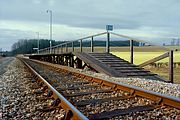 |
Combe Halt was opened by the Great Western Railway on 8 July 1935, in order to encourage more traffic on the southern half of the Cotswold Line. Unfortunately, as can be see from this view, it was not particularly convenient for passengers, being situated in open country midway between the villages of Combe and Long Hanborough. Although reduced to a single platform with the singling of the line in 1971, otherwise it probably looks much as built in this 1 March 1979 picture, apart from the modern lampposts and signage. The station remains open, but is now backed by the inevitable lineside bushes. The bullhead track was replaced by continuous welded flat bottom rails in 1984. |
|
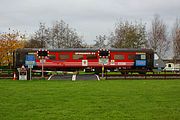 |
Ex Virgin Railways Mk 2 coach 6163 has found a very different use in retirement, being mounted on a short section of track in a field next to the 7 Lakes Country Park, Crowle, for use as a safety demonstration vehicle. It is pictured here on 28 November 2016. Note the pseudo HST nose. Various emergency services exercises take place, demonstrating level crossing safety, etc. |
|
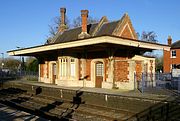 |
Culham station's Grade II listed Brunel designed station building is no longer in railway use, but has recently undergone extensive restoration, and is now in commercial use. It is pictured here in superb late afternoon light on 25 February 2018. |
|
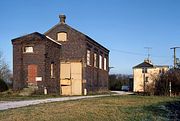 |
The tiny station at Culkerton, on the Tetbury Branch, possessed an extremely impressive brick built goods shed, seemingly out of all proportion to its remote rural location. The tall structure is pictured on 5 January 1985, over two decades after the line had closed. Since this picture was taken, the building has been largely surrounded by trees, and is now nearly invisible from the road. |
|
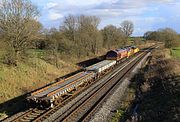 |
I couldn't resist this going away shot of the 6V25 12:30 Bescot Down Side to Hinksey departmental working at Daylesford on 13 March 2021. Three tack panels on two wagons hauled by three locos on the Cotswold Line is certainly unusual! 56094, 70809 & 66106 were heading south for some overnight engineering work. |
|
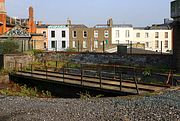 |
A remarkable survivor in the heart of a large city. The small turntable at Dublin Connolly station is pictured on 24 May 2018. Even more noteworthy than the fact that this vintage piece of equipment has survived in such an urban location, is the fact that until a few months before this picture was taken it was still rail connected, and had been in use until recently! It had been used to turn preserved steam locomotives on railtours, but its small size meant that even the diminutive Dublin & South Eastern Railway 2-6-0 No. 461 was a tight fit. Note the adjacent water tower. |
|
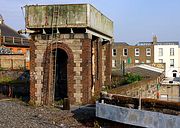 |
Many Irish railway stations retain their steam age water towers, often in a very overgrown state. The one at Dublin Connolly station was in use well after the end of regular steam workings, as it was used to service visiting railtours, which also explains the retention of the adjacent turntable. It is seen here on the morning of 24 May 2018. |
|
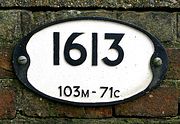 |
Time was when most railway companies identified their major civil engineering structures with cast iron number plates, rather than just painted numbers. Some still survive, although the railwayana market ensures that a lot go missing (legitimately or otherwise!). Bridge 1613 at Eccles Heath (near Attleborough) has a modern replacement cast plate in the old style (with mileage). Pictured on 27 November 2006. |
|
 |
Numerous Midland Railway boundary posts still survive in remote locations. This one was pictured on 9 April 1983 near the River Avon at Eckington. The low spring sunshine and the sharpness of Kodachrome 64 film has resulted in possibly a century's worth of rust and lichen showing up clearly. |
|
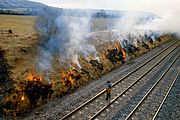 |
Lineside vegetation control - 1980s style! Although the trackside looks in excellent condition anyway (certainly by today's standards!), the long grass at Edington is being burned off on 11 March 1986, casually supervised by one track worker, who is standing in the middle of the down line. There were a couple of others workers nearby, but the whole thing seems very casual, and with trains still running past! It certainly looks like a bit of a heath & safety nightmare, but as Network Rail no longer do any kind of lineside maintenance, the problem isn't going to arise nowadays! |
|
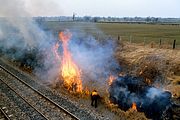 |
With the (admittedly infrequent) trains passing by just yards away, a track worker sets light to the embankment at Edington on 11 March 1986, starting a controlled burn to rid the trackside of dead grass and brambles. This was a common steam age practice, but I don't remember seeing it done too often in the 1980s. Network Rail do not do anything like this, and in fact apart from an occasional blitz to make up for years of neglect, they don't do any kind of lineside maintenance whatsoever, which explains why the national network is in such terrible condition. |
|
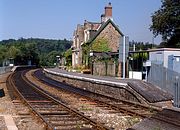 |
The archetypal country station, the flower bedecked and ivy covered Eggesford station basks in the sunshine on 1 August 1990. The station was built by the North Devon Railway. The line from Exeter to Barnstaple opened in 1854. |
|
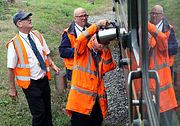 |
In a scene reminiscent of the 1953 Ealing film 'The Titfield Thunderbolt', Class 121 DMU 55032 has one of its radiators topped up at Finghall Lane on 20 July 2025. Whilst working the Wensleydale Railway's 12:00 Leeming Bar to Leyburn train, one of the unit's engines shut down due to lack of coolant. Anything that came to hand, including this kettle, was used to add water, but although the unit carried on to Leyburn, and then returned to Leeming Bar, it was decided to get Pacer 143623 ready at short notice for the next train. |
|
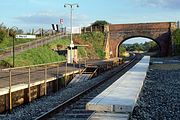 |
In 1986 Finstock station was rebuilt, moving the single platform from one side of the line to the other. When the southern section of the Cotswold Line was singled in 1971, the down line was removed, leaving just the former up platform in use. The track was realigned in 1986 to approximately the centre of the former double track formation, and a new platform was constructed on the west side of the line. Prior to this opening, a temporary platform had to be added to the old up platform, as the track was now nowhere near the platform! This view, taken on 14 September 1986, shows all three platforms. On the left is the old 1930s sleeper built platform, with its new scaffolding and plywood addition, while on the right the new platform takes shape. Once this new platform was commissioned, the old platform on the left, along with its approach gateway and path were removed. |
|
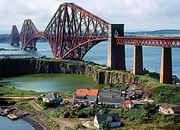 |
The unmistakable Forth Rail Bridge, photographed early on the morning on 16 July 1983, from North Queensferry. The railway bridge looks the same today, but the foreground view has altered. Deep Sea World, an aquarium with an underwater viewing tunnel, now occupies the water filled disused Battery Quarry, half of which has disappeared under their car park! |
|
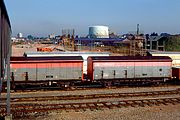 |
Gloucester New Yard pictured on 5 August 1989, with a couple of VAA vans in the foreground. This picture is taken from the old footbridge that used to cross the yard. The bridge disappeared when a new road (Metz Way) was constructed just a few yards to the north. The footings for the Metz Way bridge can be seen behind the vans. In the background is the Horton Road gas holder, which was demolished in 2012. |
|
 |
Goole once had an extensive network of sidings, principally serving the docks. This 13 March 1999 view shows the large fan of sidings to the west of Goods Yard Junction. In the 1980s withdrawn locos had been stored here, but by the late 1990s it was just home to some condemned wagons. Apart from the straight line on the extreme right of the picture, which is used as a headshunt for the docks, all the rest of this trackwork has either been taken up or engulfed by the forest of trees that now occupies the area. In the distance 37883 can be seen crossing the Dutch River with the single wagon 6D99 07:20 Hull Saltend to Immingham, with the cooling towers of Thorpe Marsh Power Station directly behind. The other two bridges on the right cross the Aire & Calder Navigation, and a disused railway. |
|
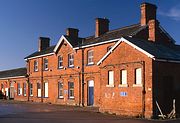 |
Goole station once boasted an impressive red brick station building, which along with many other medium sized stations across the country became increasingly ill suited to the traffic requirements from the 1960s onwards. It is pictured here on 1 January 2000 from the car park, with various windows boarded up and signs of neglect. It was not to last much longer, being demolished shortly afterwards and replaced by small box like structure with no architectural merit. |
|
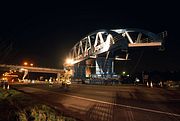 |
The doubling of the Hallen Marsh Junction to Filton freight line near Bristol in the early 1990s had one serious problem; the bridge over the M5 motorway was only single track. Consequently a new span was positioned alongside the existing bridge to take the second track. On the night of 12 February 1994, the new 360 tonne span (which had been parked on the side of the motorway for some time) was slowly moved into position. In this view the new bridge has been moved along the closed motorway and is just starting to be slewed across to meet up with the existing bridge, which can be seen in the background. |
|
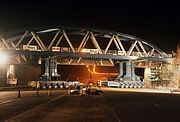 |
Not a position you can normally stand in! Viewed from the middle of the closed M5 motorway (with permission) on the night of 12 February 1994, the new 360 tonne bridge has just been postioned next to the existing Hallen railway bridge. This was to take the new double track on the Hallen Marsh Junction to Filton freight line. Note the flat area in the foreground where the central barriers have been removed in order to allow the new span to be swung round from the southbound carriageway (on the right). Engineers are now checking the position of the structure before lowering the deck onto the abutments and removing the multi-wheeled trailers. A very strange experience to be standing on a motorway in the middle of the night watching a bridge being moved! |
|
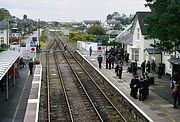 |
Harlech station provides a crossing point on the otherwise single Pwllheli to Dovey Junction line. Consequently there are relatively busy periods when two trains arrive, during what is a fairly infrequent train service. This is especially so when the schoolchildren come out of school! Children swarm all over the station on 20 October 2014, prior to catching either 158821 or 158830 with the 2J11 10:09 Birmingham International to Pwllheli Arriva Trains Wales service or 2G55 13:38 Pwllheli to Birmingham International respectively. |
|
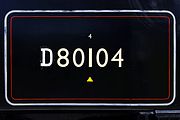 |
Due to the non arrival of most of the visiting locomotives for the Swanage Railway's 2012 Diesel Gala, resident BR 4MT 2-6-4T steam locomotive 80104 was 'upgraded' to a diesel in order to help out. A spot of renumbering was in order, so it acquired a 'D' prefix for the event. Its new cabside number is pictured here at Harmans Cross on 13 May 2012. |
|
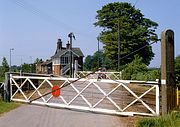 |
Havenhouse Level Crossing pictured on 14 June 1986. If it wasn't for the Bedford Rascal van (ironically brand new when this picture was taken), this could easily be a scene from decades earlier. Vintage wooden gates, signal box, and a Great Northern Railway somersault signal all add to the timeless atmosphere. All this has now gone, although thankfully the station building still survives. |
|
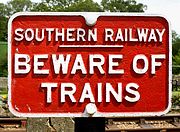 |
A cast iron Southern Railway 'Beware of Trains' notice at Havenstreet on 29 May 2013. Once a common sight all over former SR lines, even into BR days, most of these have now either officially or unofficially disappeared, only to be seen at places such as the Isle of Wight Steam Railway. |
|
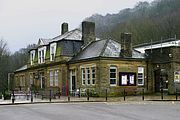 |
Hebden Bridge station building, pictured on 16 March 2015. The building was constructed in 1893 by the Lancashire and Yorkshire Railway, and replaced an earlier structure which had served the town since the opening of the line by the Manchester and Leeds Railway in 1840. |
|
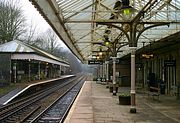 |
The staggered platforms of Hebden Bridge station, pictured on 16 March 2015. The station was opened by the Manchester ad Leeds Railway in 1840, although this station is a later rebuild. For once I was glad that the weather was so bad, as this picture would have been impossibly shadowy if the sun had decided to come out. |
|
 |
Heyford station (between Banbury and Oxford) became an unstaffed halt in the 1960s, but for a long time retained its original Great Western Railway station building. This fine stone structure is pictured on 17 September 1983, when in private use. Note how the platform must have originally been much lower, as the door into the building is now well below the current platform level! Unlike its near neighbour, Aynho, it was not converted into a private dwelling and was replaced by a basic 'bus shelter' in 1986. |
|
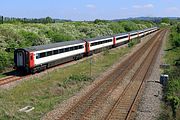 |
A rake of ten perfectly good Mk3 coaches going into store on 7 May 2020, pictured here passing Honeybourne, being hauled by 37402 Stephen Middlemore 23.12.1954 - 8.6.2013 & 37716. The train is the 5Z50 08:00 Mid Norfolk Railway Siding to Long Marston ECS, conveying ten ex Greater Anglia coaches: 12090, 12159, 12034, 12049, 12126, 12116, 12118, 12137, 12046 & 12164. |
|
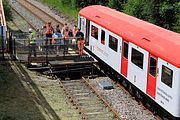 |
The least platform that you can get away with! As in previous years, a temporary platform was constructed at Honeybourne station in 2021, in order to transfer passengers onto a Vivarail unit taking them to the Rail Live event at Long Marston. Passengers are picturing leaving 230010, which has just arrived at the scaffolding and plank constructed platform, with the 14:00 shuttle service from Long Marston on 16 June 2021. |
|
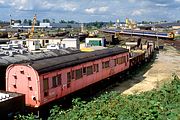 |
QPV staff coach DS230, pictured at Horsham on 17 July 1993. This former London & South Western Railway coach entered departmental service during early BR days. It carries the branding 'On loan to Chipman Chemicals Ltd'. Despite its age, it managed to survive in the yard at Horsham for many years after this picture was taken, but was finally cut up on site. A pair of Network SouthEast Class 421 4-CIG EMUs can be seen leaving the station in the background. |
|
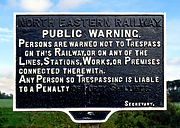 |
As late as 30 August 1993 this cast iron North Eastern Railway trespass notice was still serving its original purpose next to the York to Scarborough line at Huttons Ambo. Rather than replacing it with a more modern version, the former owning company and pre-decimal penalty have been painted out. I can't imagine that this still survives, as if Network Rail haven't replaced it by now, it has sure to have been spirited away into someone's railwayana collection! |
|
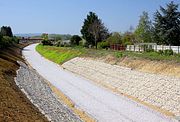 |
The upgrading of the Oxford to Bicester line is completely transforming what was once a sleepy backwater, with just a few trains each day. The reconstruction work is to a very high standard, with renewal of the trackbed, and numerous associated earthworks. This is the view south from Islip on 21 April 2015, with the bridge replacement for the former Mill Lane crossing in the background. Such is the extent of the work, that the only real clue that this view is the same as where I pictured D1015 Western Champion in 2013 is the tree in the centre of the picture! |
|
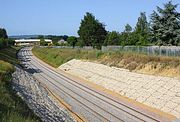 |
This is the view south from the road bridge in the village of Islip on 9 July 2015, showing the recently installed track for the upgrading of the Oxford to Bicester line, and the new bridge under construction near the site of Mill Lane level crossing. This view makes an interesting comparison to the same location pictured a few months earlier, before the track was laid. |
|
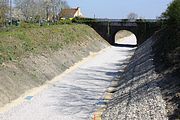 |
The new trackbed, freshly covered with a layer of brilliant white ballast, at Islip on 21 April 2015. The Oxford to Bicester line is being upgraded as part of Chiltern's new route to London, and for the East West Rail project. This is the cutting between the two road bridges, a location that was formerly very overgrown, and is hardly recognisable from the same view in 2012. |
|
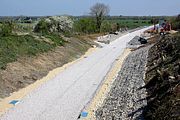 |
Islip's new station takes shape on 21 April 2015. Fresh ballast has just been laid, and the supports for the new platforms are in situ. It must be lunchtime, as not a lot of work appears to be going on! The upgrading of the Oxford to Bicester line is part of Chiltern Railway's scheme to run trains from Oxford to London, via a new chord at Bicester. |
|
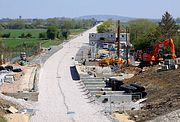 |
The rebuilding of Islip station, pictured on 21 April 2015. A ribbon of brilliant white ballast across the Oxfordshire countryside marks Chiltern Railway's upgrading of the Oxford to Bicester line, which had for many years been a sleepy single track backwater. All trace of the previous small station has disappeared under this new construction, but the gate on the left, visible just above the new platform marks the entrance to the former rail served oil terminal. In the background a new footbridge takes shape, which mostly obscures a new road bridge at Oddington, in the far distance. The hill on the horizon is Graven Hill, home to the Bicester Army Depot. |
|
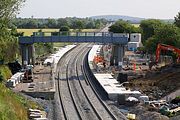 |
Islip station under construction on 9 July 2015. The platforms are nearly complete, and the footbridge has been installed since I photographed this location a few months earlier. Just visible in the far distance near Oddington is a track machine on the newly installed up line. |
|
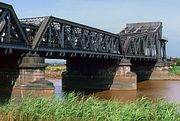 |
Keadby Bridge (also known as the King George V Bridge) carries the Scunthorpe to Doncaster railway, and the A18 road, over the River Trent at Althorpe. The rolling lift bridge was built between 1912 and 1916, replacing an earlier swing bridge. This view, taken on 26 July 1986, shows the railway side of the bridge, with the lifting section on the right. The bridge was last raised in 1956, and was modified and fixed into position a few years later. |
|
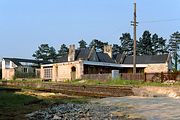 |
Kemble station, pictured on 21 May 1988. The line in the foreground is the former Cirencester branch platform, which now terminates at a buffer stop just off to the right of the picture. The station is Grade II listed, but that didn't stop Network Rail trying to get part of this disused platform removed in 2013. Thankfully Cotswold District Council refused this application. |
|
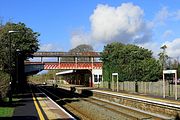 |
Kemble station under a cloud on 24 February 2025, untroubled by any trains! I had gone here to photograph 57310 on the 5Q89 12:34 Long Marston to Eastleigh East Yard, conveying South Western Railway EMU 701060, but that only got as far as Worcester, where 57310 was declared a failure. There wasn't even any passenger trains to photograph, as the 1L78 13:59 Cheltenham Spa to Paddington had been cancelled. In fact on this day no less than eight of GWR's trains had been cancelled, with such excuses as 'lineside vegetation' (totally believable!) to 'adverse weather conditions' (a complete lie). 5Q89 was rescheduled to run the following day as the 5Q91 13:38 Worcester North Sidings to Wimbledon Park Depot Sidings. |
|
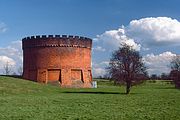 |
Kilsby Tunnel, on the London & Birmingham Railway, was designed by Robert Stephenson, and opened in 1838. At the time it was the longest railway tunnel in the world. It is notable for the two original ventilation shafts, which feature massive castellated brick towers. The northern shaft, next to the A5, is pictured on 17 March 1989. |
|
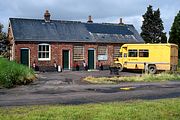 |
Kingham station was once an important junction, with lines diverging from the Oxford to Worcester line to Cheltenham in the west, and Banbury in the east. This lead to the construction of a far larger station than was strictly necessary for its rural location. After the Cheltenham and Banbury lines closed, its importance diminished, and during the mid 1970s its extensive brick built station buildings were demolished. One GWR building did survive, and is pictured here on 4 June 1983. This was situated at the north end of the site, near the diverging line to Cheltenham. There are plenty of period details here for the modeller, including: fire buckets, grindstone, an altered doorway, repaired roof, etc. The British Rail van is also now historic! The building has since been demolished, and an industrial estate now occupies the site. |
|
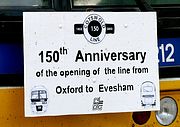 |
The Cotswold Line Promotion Group's homemade 'Cotswold Line 150' headboard fixed to the front of 166212 on 8 June 2003. Pictured at Kingham on the return working of the CLPG's Oxford to Evesham special, commemorating the line's opening in 1853. |
|
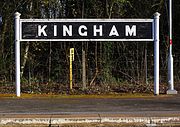 |
Although Kingham station's elaborate GWR brick station building was demolished in the 1970s, the station does retain some Great Western identity, as it retains traditional GWR style running in boards. The up station name board is pictured, along with the 84¾ milepost, on 10 December 2014. |
|
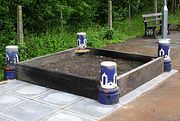 |
Not so much a piece of infrastructure, more a piece of ex-infrastructure! The old Great Western Railway footbridge at Kingham station was replaced by a more modern structure in February 2016. Rather than excavate the base of the columns (which presumably go down quite a distance below the platform surface), the columns were cut off to leave short stumps. These were then filled with concrete, and timber added to form a flower bed. An excellent piece of improvisation! Picture taken on 28 May 2016. |
|
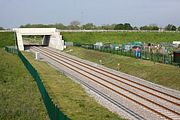 |
Almost ready for the first trains. The brand new A4421 bridge at Launton, pictured on 11 May 2024. The new double track mainline is part of the East West Rail project, linking Oxford with Milton Keynes. This location was formerly a single track normally freight only line, and had become very overgrown, so much so that the slightly more head on view from 2018 is totally unrecognisable! |
|
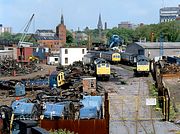 |
A general view of Vic Berry's scrapyard at Leicester, taken on 31 May 1987. The remains of a Class 501 EMU is surrounded by piles of scrap, with various loco cabs stored in the foreground. Still in one piece on the right are 25037 & 25095, along with a couple of Class 101 vehicles. |
|
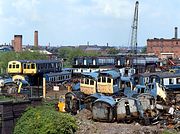 |
Vic Berry's scrapyard at Leicester, pictured on 31 May 1987. A pile of Class 25 cabs is topped off by the cab of 25284, while on the left Class 101 DTCL 54411 and Class 104 DMBS 54422 are similarly perched high in the air, sitting on other redundant rolling stock. The background is dominated by condemned Mk1 sleeper coaches. |
|
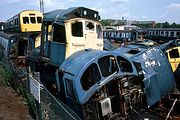 |
Class 25 and 40 cabs share Vic Berry's scrapyard at Leicester with assorted coaches and DMU vehicles, including a Class 101 driving trailer. This scene of chaos was captured on 31 May 1987. This is the view from the public footpath that ran alongside the site (note the trespass notice in the foreground). Some of the loco parts were identifiable, but some were not, as the numbers and TOPS panels had been cut out for sale to enthusiasts. |
|
 |
The mangled remains of Class 40 and 25 cabs litter the foreground of this view of Vic Berry's Scrapyard, Leicester, on 31 May 1987. A still complete Class 25 can be seen amid the coach bodies in the background. Just visible in the far distance on the right is the replica of New York's Statue of Liberty, standing on top of the old Liberty shoe factory in Eastern Boulevard. This building was demolished in 2002, but the statue was saved, and can now be seen at the junction of Upperton Road and Western Boulevard. |
|
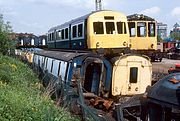 |
A pile of coaches and DMU vehicles at Vic Berry's scrapyard at Leicester, pictured on 31 May 1987. Class 101 DTCL 54411 sits on top of the pile, next to Class 104 DMBS 54422. Underneath is a Mk 1 sleeper coach, while a line of Class 27 cabs can be seen in the background. |
|
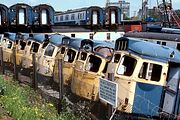 |
Vic Berry's scrapyard at Leicester was famous in the 1980s for the easily visible piles of scrap locos and coaches. This is a typical view on 31 May 1987, with a line of Class 26 & 27 loco cabs, backed by a stack of condemned Mk1 coaches. As this picture was taken from a public footpath, the notice in the foreground was probably quite necessary. |
|
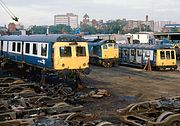 |
Some Class 120 DMUs had an extended lease of life by being stripped of all seating, and converted into parcels vehicles. One such was DMBC M53714, forming part of set EP (Etches Park) 522. It was withdrawn in April 1987, and is seen here in Vic Berry's scrapyard, Leicester, on 26 September 1987, in the company of 25059, and another unidentified DMU vehicle. |
|
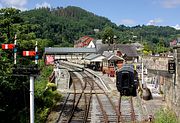 |
Llangollen station basks in the sunshine on Sunday 9 July 2023. The signals on the left control access to the platforms from the headshunt, which terminates under a road bridge. Originally they would have been the inner home signals for trains approaching from Ruabon. The line through Llangollen closed to passengers in 1965, but the Ruabon to Llangollen section remained open for freight for another three years. The Llangollen Railway opened as a preserved line in 1975, albeit with only a few yards of track. Track reached Pentrefelin in 1981, Berwyn in 1986, Deeside Halt in 1990, Glyndyfrdwy in 1993, Carrog in 1996, Corwen East in 2014, and finally a new station at Corwen in 2023. |
|
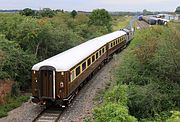 |
The most luxurious ever barrier vehicles! Pullman coaches Snowdon & Ben Lomond arrive at Long Marston on 7 September 2020 behind 37688 Great Rocks, running as the 5Z20 07:08 Crewe to Long Marston ECS. They would shortly be used as barriers for the three ex GWR Mk3 HST coaches which can be seen in the background. |
|
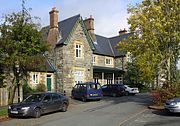 |
Machynlleth station was opened in 1863 by the Newtown & Machynlleth Railway. The impressive stone station building, designed by the Chester architect Thomas Penson, still survives. This is the view from the road approach on 19 October 2014. Machynlleth was formerly the southern terminus of the narrow gauge Corris Railway. The Corris station was adjacent to the standard gauge station, but at a lower level. |
|
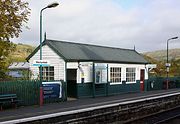 |
Machynlleth station is still full of character. Even the wooden waiting room on the up platform still survives, having managed to avoid being replaced by the ubiquitous 'bus shelter', although one has been provided a little further along the platform, underneath the footbridge. It is pictured here on 19 October 2014. |
|
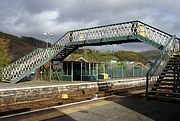 |
Machynlleth station footbridge, pictured during a brief sunny spell on Sunday 19 October 2014. Presumably of GWR origin, it still looks it pretty good condition, despite needing a coat of paint. However, not being accessible by the disabled, it could easily be removed in favour of a hideous modern replacement! |
|
 |
The impressive Medway Viaduct on the Channel Tunnel Rail Link (HS1), and the adjacent new M2 motorway viaduct, both under construction on 11 May 2002. The original Medway Bridge on the M2 (opened in 1963) can be seen on the left. Both the new bridges were opened in 2003. |
|
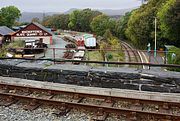 |
A panoramic view of the narrow / standard gauge interchange at Minffordd, pictured on 19 October 2014, with the 1 ft 11½ in gauge Ffestiniog Railway in the foreground, and the standard gauge Pwllheli to Dovey Junction line in the background on the right. The diminutive Minffordd station is on the extreme right, situated on a tight curve, with the platform extending underneath the bridge carrying the Ffestiniog Railway. The overgrown remains of the exchange sidings can be seen. This is where slate was transshipped from the Ffestiniog to the standard gauge line. At one time the volume of slate transshipped exceeded that which was exported via Porthmadog. Nowadays the yard is used as a permanent way depot. |
|
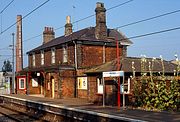 |
A fine show of hollyhocks at Mistley station on 26 August 1991. Situated not far from the River Stour, it is the first station on the Manningtree to Harwich line. The Eastern Union Railway 1854 built Italianate station building is no longer used by the railway, and has been considerably smartened up since this picture was taken. The distinctive chimney still dominates the scene. |
|
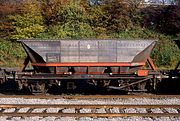 |
The HAA coal hopper was one of the most successful wagon types of the 1960s, completely revolutionising the movement of coal between collieries and power stations, using what became known as the 'merry-go-round' principle. Over 11,000 of these wagons were built between 1964 and 1982. 359473 is pictured at Moira West Junction on 23 October 1989. |
|
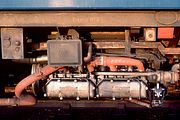 |
The Leyland 680 six cylinder 11.1 litre diesel engine was used extensively on first generation DMUs, with a pair of engines on each powered vehicle. No.2 engine is pictured on Class 119 DMS 51085 (set L593) at Moreton-in-Marsh on 9 April 1983. Class 119s originally had AEC engines. It looks like this engine has had some welding work done to the rocker covers. |
|
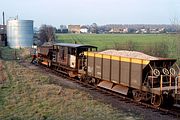 |
An interesting and now historic view of the former Shipston-on-Stour branch at Moreton-in-Marsh station, photographed on 5 April 1984. The Shipston-on-Stour branch started life as the Stratford and Moreton Tramway, opening as early as 1826. The branch to Shipston followed ten years later, and the line was later converted to a conventional railway, with the tramway section to Stratford-upon-Avon being lifted in 1918. This view shows the truncated remains of the line at Moreton, with the branch's route now blocked by a modern silo. This remained as a siding for many tears, and is here playing host to a ballast train waiting for the following weekend's engineering works. I cannot quite read the number of the ZFV Dogfish wagons against the buffer stop, but the ZUV Shark plough brake van is DB993904, and the loaded YGH Sealion hopper in the foreground is DB982630. |
|
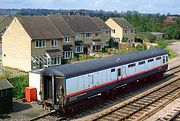 |
An unusual visitor to Moreton-in-Marsh on 19 April 1992. Mobile Rack Assessment coach DB977338 is parked in the down refuge siding, reason unknown. This was formerly Mk 2 9387. It was often worth a look at Moreton-in-Marsh on a Sunday, as in the 1980s and 90s there would occasionally be something unusual stabled in this siding. |
|
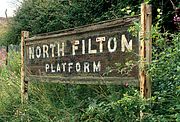 |
North Filton Platform was a diminutive stopping place, latterly in the shadow of Bristol Airport. It closed to passengers in 1964, but was still used afterwards for unadvertised workers services. The final train called in 1986. Although much decayed, the original name board was still intact, amid the brambles and the Rosebay Willowherb on 23 July 1993. |
|
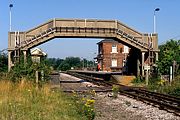 |
North Weald station, with its original concrete footbridge, pictured on 22 July 1993, just over a year before the line closed. The conductor rails, and cables crossing the bridge clearly indicate that this was part of the London Underground network, but the rural Essex location is just about as far removed from most people's idea of the underground as it is possible to get. In 1993 trains only operated during the morning and evening peaks. After closure the line became the Epping Ongar heritage railway. Although the station building and signal box survive, unfortunately the footbridge's internal steel reinforcing rods were suffering from serious rust due to water ingress, with the result that bits of concrete were dropping off. The decision was taken to demolish it and replace it with a steel bridge recovered from Churchfields on the Central Line. |
|
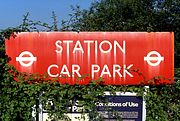 |
Signs of neglect at North Weald on 22 July 1993. Brambles encircle the London Transport enameled station car park sign, with its more modern conditions of use notice. The little station on the Epping to Ongar line was only served by a couple of morning and evening peak trains, so all the signage seems a bit over the top. In fact my car was the only one there on this sunny morning! |
|
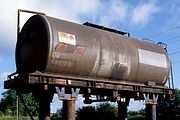 |
It used to be quite common to see grounded railway van bodies used for all kinds of non-railway purposes, after their life on the railways was over. In more recent times I have even seen a former Avon County Council 'Binliner' rubbish container in farm use, ironically on the course of the disused Fairford Branch. Railway tank wagons are less commonly seen, but on 6 July 1985, I came across this one high up on the Cotswolds near Northleach. Minus its wheels, former BRT tank 57120 was being used to store diesel for vehicles involved in laying a cross country pipeline. The elevated position meaning that it could gravity feed the vehicles. |
|
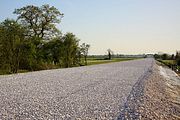 |
A broad expanse of fresh white ballast at Oddington, on the Oxford to Bicester line, pictured on the evening of 21 April 2015. This view is looking back towards Islip, with the tower of St Nicholas church visible on the horizon. This extensive engineering project is transforming the route into a modern high speed mainline. |
|
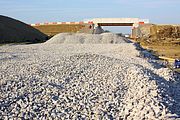 |
A new road bridge takes shape at Oddington, on the Oxford to Bicester line, seen here on 21 April 2015. There was a formerly a level crossing, giving access to Barndon Farm and Oddington Grange. The new bridge replaces that, and is part of the upgrading of the whole route in connection with Chiltern Railway's new route to London, and the East West Rail project. |
|
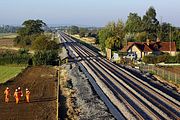 |
An early morning view of the new track works at Oddington, on the redoubled Oxford to Bicester Line. Rail workers walk back towards the new road, after putting finishing touches to the lineside fence on 30 September 2015. There was formerly a level crossing just in front of the house. A new footbridge can be seen in the background, with Islip station in the far distance. Islip church is on the extreme left. I had hoped to get one of the crew training DMUs, but unfortunately this morning's trains had been cancelled! |
|
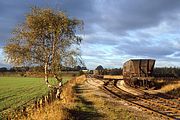 |
Littleton Colliery was served by a short branch line that diverged from the West Coast Mainline just to the south of Penkridge station. Unfortunately I never did manage to photograph a train on the line, but on 2 November 1985, I took this picture of a rake of HAA MGR wagons at Otherton Sidings, at the point, approximately a third of the way along the branch, where the line changes direction. I presume the three wagons on their own are cripples, that have been detached from various trains. The M6 motorway can be seen in the background. I particularly like the lighting in this picture, and the composition is certainly helped by the inclusion of the silver birch tree. The colliery closed in 1993, and this track has now been lifted. |
|
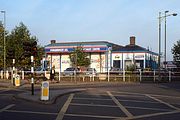 |
Oxford originally had two railway stations, the Great Western Railway through station on the Didcot to Banbury line, which in a much modified form is still in use today, and the London & North Western Railway (later LMS) terminus. This was closed to passengers in 1951, with all services transferred to the adjacent GWR station. Goods traffic lingering on until 1984. Even though a largely prefabricated design, the building was quite impressive, and acquired grade II listing. It is pictured here on 21 October 1988, over a decade before the building was dismantled and transferred to the Buckinghamshire Railway Centre at Quainton. |
|
 |
47587 was named Ruskin College Oxford at Oxford station on 3 October 1990, in a double ceremony with 47547, which was named University of Oxford. On the left is Dr Stephen Yeo (Principal of Ruskin College), who has just unveiled the nameplate on the side of 47587. Standing on the podium, in the centre of the picture is Roy Jenkins, the Right Honourable Lord Jenkins of Hillhead (Oxford University Chancellor), who had just unveiled the plates on 47547. On the right of the picture is the Lord Mayor of Oxford, Queenie Hamilton. |
|
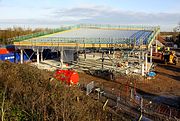 |
This is the new Oxford Parkway station under construction, pictured on 15 December 2014. This will be the first new station to be opened in Oxfordshire since 1944 (not 1935 as quoted by Chiltern Railways). It is on the site of the former Second World War grain silo near Water Eaton. It is also the site of the Banbury Road stone terminal, and 59201 can just be glimpsed on the left of the picture, at the head of a stone train from Whatley, that is in the course of being unloaded. Unfortunately this was in a totaaly unphotographable position right up against the road overbridge. |
|
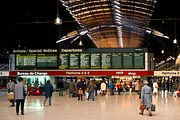 |
Paddington Station concourse, pictured at 11:20 on 22 November 1986. The huge arrivals and departures board has since been removed, giving passengers a much better view of the impressive roof, designed by Isambard Kingdom Brunel and Matthew Digby Wyatt. As well as the usual departures for Weston-super-Mare, Reading, Penzance, Didcot Parkway and Swansea, the board also informs us that: 'Today's Sealink sailing from Rosslare to Fishguard has been cancelled due to rather nasty bit of weather'! |
|
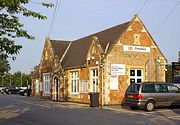 |
Pewsey station still retains its original brick built station building, seen here in golden early morning light on 23 August 2013. The Berks & Hants line was opened as a broad gauge route in 1862, to provide a quicker route to the West Country compared to the Great Western Railway's original line via Bristol. Today the station is well used, serving not only the small town of Pewsey, but also the nearby larger towns of Devizes and Marlborough, now both devoid of railways. |
|
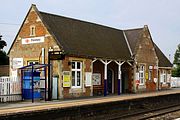 |
Pewsey station building, pictured from the platform side on 23 August 2013. Note the small integral canopy, which is sheltering a typical GWR station bench. The Victorian structure has been brought up to date with various modern fittings, including an audio help point, portable access ramps, automatic ticket machine and the inevitable posters reminding you to pay for car parking! |
|
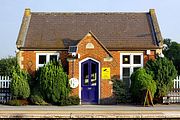 |
In 1984, Pewsey station's original up platform wooden waiting shelter was replaced by this splendid brick built structure, almost completely matching the original 1862 built station building on the opposite platform. This was a remarkable event, considering that in the 1970s and 80s the usual replacement would have been the ubiquitous 'bus shelter' type structure. Nearly three decades after it was built, it is now looking even more like its nearby Victorian inspiration, as it is starting to accumulate a good covering of lichen. Picture taken on 23 August 2013. |
|
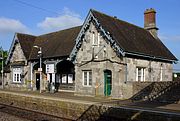 |
Portlaoise Station Building, pictured on 22 May 2018. Originally called Maryborough, the station was opened in 1847 by the Great Southern and Western Railway. It later became a junction, with the opening of the Waterford & Kilkenny Railway. The station ceased to be a junction in 1963, after the closure of the short branch to Abbeyleix. The line to Kilkenny had closed the previous year. |
|
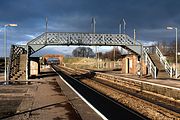 |
Radley station, pictured in extremely dramatic lighting on 28 November 1981. Although the station buildings had been demolished in the 1970s, the GWR footbridge survived until 2008, when it was replaced by a more modern structure. By then the road bridge seen here in the background had also been rebuilt. Note the large metal hoops over the footbridge that formerly supported a roof. In 1981 Radley station saw very little use, but unlike today, there was road access to both platforms. |
|
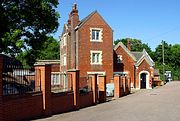 |
Reedham station in Norfolk opened by the Great Eastern Railway in 1904, replacing the earlier 1844 station, which was situated a little further to the east. The elaborate brick built station building (Now a private residence) is pictured on 26 May 2017. |
|
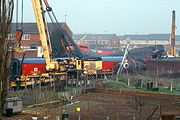 |
On 8 March 1996 the Mossend to Willesden Transrail freight train derailed at Rickerscote (just south of Stafford), after an axle on one of the liquid carbon dioxide tankers failed. Unfortunately the wreckage was almost immediately struck by 86239 hauling the 1S09 Cardiff to Glasgow TPO. This is the scene two days later, with recovery operations underway. 86239 has jack knifed, and come perilously close to the nearby house. The crane is about to lift one of the TPO vehicles, while one of the CO2 tankers can seen wedged up against one of the catenary masts. |
|
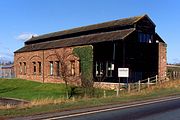 |
Ross-on-Wye lost its railway during the Beeching cuts of the 1960s. The passenger station closed in November 1964, and the goods yard a year later. Although the station building has been demolished, the goods shed and the engine shed survive. The impressive 1855 built engine shed is pictured on 2 March 2003, when there was an unobstructed view of the building from the Ross bypass. Trees now largely hide the former broad gauge structure from view. Note the wagon positioned at the far end of the building. |
|
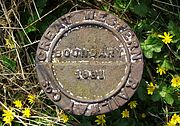 |
Along with most other Victorian railway companies, the Great Western Railway was very keen to mark out the exact boundary of its property. It installed numerous cast iron boundary posts along the borders of its domain, and amazingly a vast number still survive. This 1881 example is pictured amid the Lesser Celandines at Rousham on 18 April 2010. Obviously painted white at some time, just a few flakes of paint now remain. |
|
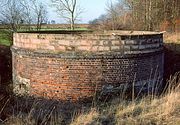 |
The 1,864 yard long Sapperton Tunnel originally had four airshafts, only two of which now survive. This is the southernmost one, pictured on 26 December 1983. It is rather short, and of quite a large diameter. Obviously there were concerns in the past that it was too short, hence the rather crude breeze block height extension. |
|
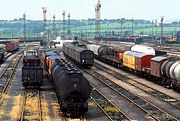 |
Severn Tunnel Junction Yard, pictured on 30 June 1985. Note the huge variety of wagons types, and the still healthy level of traffic. At this time the yard was a main Speedlink hub, but two years later the entire site, and the adjacent loco depot, was closed. Gloucester took over a lot of the yard's work, until the Speedlink network was withdrawn in 1991. |
|
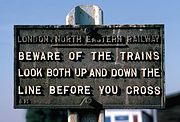 |
Nearly four decades after the nationalisation of the railways, this cast iron LNER sign was still fulfilling its purpose at Shippea Hill on 20 September 1986. No mention of British Rail, just leave the London & North Eastern Railway wording unpainted! I expect this is now in someone's railwayana collection! |
|
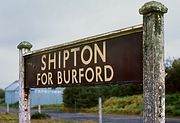 |
A piece of steam age railwayana surviving at Shipton station in 1979. Surprisingly, despite the presence of corporate BR signage on the station, the large enamel 'Shipton for Burford' sign still survived on the up platform. This picture was taken on a very gloomy 13 October 1979, and I was going to return shortly afterwards for a photo in better light. However, when I got around to going again, it had gone. Whether this was a legitimate removal or a 'rescue' by other interested parties is difficult to say. It proves that you should always take pictures of things that may disappear! |
|
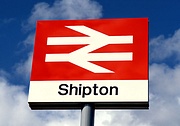 |
The universally recognised BR 'double arrow' logo was one of the products of the 1964 rebranding programme, and even in this era of privatisation has come to represent the national network. It was once used on everything from the humblest item of literature right up to rolling stock and of course, station signage. Here is the sign for my local station at Shipton, looking almost brand new (perhaps it was) on 25 July 1993. It has since suffered the ravages of time and neglect. |
|
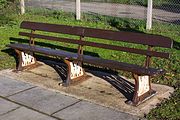 |
Shipton station on the Cotswold Line has only very basic facilities, but it does now have a replica Great Western Railway seat. It was installed by the Cotswold Line Promotion Group in memory of local flour mill owner, Ian Marmaduke Matthews, who died in 1999. It is pictured in the autumn sunshine on 15 November 2013. |
|
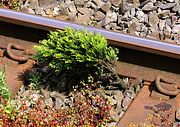 |
Weeds growing on railway tracks are commonplace on the national network nowadays due to Network Rail's neglect, but this bonsai conifer happily growing in the ballast at Shipton station is a different order of poor maintenance. Sculpted by the passage of westbound trains, this small tree was photographed (with a long lens) from the down platform on 15 June 2016. The old style GWR gangers would be shocked at the state the track is now allowed to get into. |
|
 |
The level crossing on the Shrivenham to Ashbury road was closed in the 1970s, and a concrete footbridge was provided to the side of the original crossing. This became one of my favourite photographic locations in the Vale of White Horse, so I have included this picture of the bridge taken in stunning late evening lighting on 9 June 1987. The village of Ashbury, after which the former crossing got its name, can just be seen in the distance. |
|
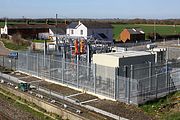 |
Railway electfrication requires substations at intervals along the line, to supply power to the overhead wires. Third rail electfrication requires frequent substations, but 25kV needs far fewer. This is a view of the substation being built on the site of Shrivenham station, to supply power to the new Great Western Mainline electfrication. Note that despite all the work that has gone on since the station closed, the platform is still in existence, and looks set to remain. The white building in the background is the former Victoria Hotel, latterly the Fat Dog restaurant, and now a private residence. Photo taken on 13 March 2017. |
|
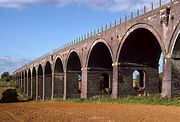 |
The Chiltern line crosses two viaducts as it approaches Aynho Junction, where it joins the Oxford to Banbury line. Both these structures cross small tributaries of the River Cherwell. This is the southernmost of the, Souldern No.1 Viaduct, pictured on 11 September 1988. |
|
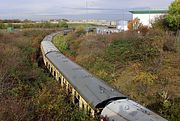 |
My first picture of a train on the South Marston Euro Terminal branch. The Pathfinder Tours 1Z75 06:34 Burton-on-Trent to Banbury 'Cotswold Caper' railtour on 29 October 2022 stands on the exceedingly overgrown line, with 37676 Loch Rannoch stopped at the compound gates in the distance, and 37668 at the back of the train, two coaches behind me. This short branch line was opened in the early 2000s, but has seen hardly any use, apart from a few erratic trains from the Honda factory, which can be seen in the distance (now closed). |
|
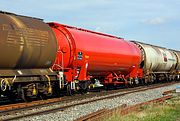 |
Ex works TEA bogie tank wagon 89004 really stands out compared to its much more typically grubby neighbours, as it forms part of the 6B13 05:02 Robeston to Westerleigh Murco train at Standish Junction on 24 September 2016. The train was being hauled by 60054. Not only is the wagon in a different livery to its neighbours, but also all three wagons in this picture show detail differences of design. |
|
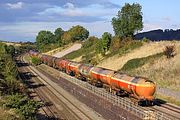 |
The one that got away! Despite leaving home in plenty of time to get to Standish Junction to photograph the diverted 6B33 13:00 Theale to Robeston Murco oil empties on 12 October 2016, I was most annoyed to find the train passing underneath the bridge as I arrived! It had managed to become half an hour early since I checked just before leaving home. So here for all wagon enthusiasts is the going away shot, with 60019 Port of Grimsby & Immingham heading off into the distance. The superb light, plus the unusual location (for 6B33) makes the picture worthwhile. Note the 'End' wording that someone has thoughtfully added to the last wagon! |
|
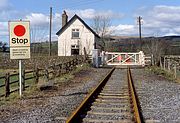 |
Unthank level crossing, near Stanhope, pictured on 10 April 1993. The closure had just been announced for the Weardale line, and clearly no trains had passed this way for a few days. That was to change shortly after this picture was taken, when 37506 British Steel Skinningrove & 37512 Thornaby Demon would traverse the branch with the Pathfinder Tours 1Z43 04:50 Swindon to Eastgate 'Weardale Explorer' railtour. |
|
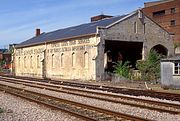 |
Stroud Goods Shed is a remarkable survivor, still sporting its GWR lettering. Designed by Brunel for the broad gauge Cheltenham and Great Western Union Railway, the building is now quite naturally grade 2 listed. It is pictured here on 4 August 1991, just after the fitting of a new roof, but long before the fitting of the current roller shutters doors. The ineffective chestnut pale fencing has also now been replaced by new palisade fencing. |
|
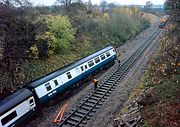 |
There was a derailment on the Cotswold Line on 30 November 1984, when the 1A20 07.05 Hereford to Paddington service came off the track near Stoulton. A broken fishplate was the cause. This is the scene on the following day, 1 December 1984, showing a pair of Mk2 coaches waiting to be lifted back onto the track by Cowans Sheldon 76 tonne diesel crane ADRC96704. |
|
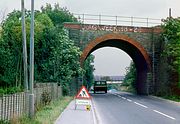 |
A minor piece of Swindon's railway history, that disappeared long ago, and was probably rarely photographed. This is the bridge carrying the former Midland & South Western Junction Railway over the A420 (now the A3102), with the Great Western Mainline bridge in the background. When this picture was taken, on 22 August 1978, the rails were still in place on top of the bridge, although the line had been disused for many years. This scene is totally unrecognisable today, with the bridge in the background being the only point of reference. The MSWJR bridge has been demolished, and the road converted into a dual carriageway. |
|
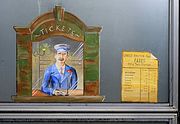 |
The temporary footbridge at Tackley station has received some unusual artwork. It has been a long time since you could buy a ticket at the station, but this painted ticket window and the list of very cheap fares to various stations (including a couple of nearby closed ones) is an amusing touch. At the other end of the bridge there is another artwork. Photo taken on 5 June 2025. |
|
 |
An amusing artwork has appeared on the temporary footbridge at Tackley station, depicting a not very realistic steam loco and train. At the other end of the bridge there is a picture of a station ticket window. Photo taken on 5 June 2025. |
|
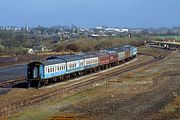 |
During the 1990s the sidings at Thingley Junction were used to store a variety of rolling stock pending possible preservation. At various times the remote location hosted several locomotives, even at one time including 50017 Royal Oak. This 17 March 1995 view shows a line of withdrawn Mk1 coaches awaiting their fate. The town of Chippenham can be seen in the background, with St Paul's church on the left. |
|
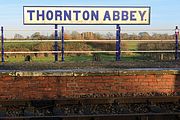 |
Thornton Abbey station is situated on the Barton-on-Humber branch, in a very rural location, some way from the nearest village. It is named after the medieval abbey, the imposing gatehouse of which can be seen beneath this picture of the station's prominent running in board, photographed on 2 December 2019. The abbey was of course closed in 1539, as part of Henry VIII's Dissolution of the Monasteries. The surviving gatehouse is notable as being one of the very earliest large scale brick buildings in England. |
|
 |
After closing in 1976, the track remained in situ at Toddington station for a further three years, but was lifted before the Gloucestershire Warwickshire Railway could take control of the site. The society moved in in 1981, and by the following year there were distinct signs of preservation progress. This view shows Toddington station building on 13 March 1982, with the first few courses of bricks in place for the soon to be reinstated platform. |
|
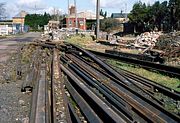 |
Toddington station, pictured on 13 March 1982, shortly after the Gloucestershire Warwickshire Railway took over the site. I'm not sure if the lengths of rail in the foreground are left over from track lifting a couple of years earlier, or whether they have been brought to the site to start track relaying. |
|
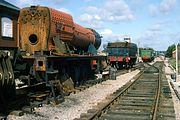 |
Very early preservation days at Toddington on 13 March 1982. Just a year after the Gloucestershire Warwickshire Railway took over the site, the first sections of track are down, and several steam locos in various states of disassembly form a line between the goods shed and the station, the most complete of which is the freshly painted GWR Hall Class 4-6-0 5952 Cogan Hall, which can be seen in the distance. |
|
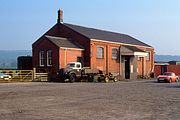 |
Toddington Goods Shed, pictured on 31 March 1990, before it got hemmed in by more modern buildings. The Gloucestershire Warwickshire Railway had been on the site for less than a decade at this time. The GWR lorry naturally still survives, as does the red Triumph Spitfire (although not currently on the road). |
|
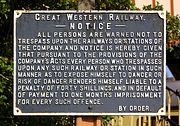 |
In addition to preserving the track, buildings, and of course the rolling stock, Britain's preserved railways also contain a myriad of smaller preserved artifacts. This cast iron Great Western Railway trespass notice was pictured at Toddington, on the Gloucestershire Warwickshire Railway, on 29 September 2013. |
|
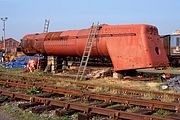 |
Painted in red oxide primer, the firebox and boiler of Southern Railway Merchant Navy Class 4-6-2 35006 Peninsular & Oriental S. N. Co. really stands out in the late afternoon light at Toddington on 31 March 1990. The loco had arrived at the Gloucestershire & Warwickshire Railway in 1983, but the painstaking restoration would be a long affair, with the loco finally entering traffic in 2016. |
|
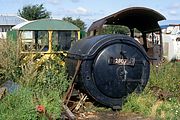 |
A jumble of miscellaneous railway equipment, pictured amid the weeds in the Gloucestershire Warwickshire Railway's Toddington Yard on 7 August 1993. The smokebox from GWR 28xx 2-8-0 2807 sits next to Wickham Trolley Type 27A Mk III, No. 7516. |
|
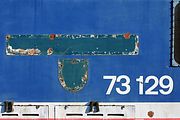 |
An ex nameplate! 73129's bodyside clearly shows where the City of Winchester nameplate and crest were affixed. The removed plates also reveal the former BR corporate blue colour scheme underneath the faded Network SouthEast livery. The various patches of bare metal only give a hint of the terrible condition of the loco's bodywork at this time (4 November 2006), when pictured at Toddington station. At several places there were holes where the steel sheet had completely rusted through. After running for several years in the Gloucestershire Warwickshire Railway in this condition, major bodywork restoration was finally undertaken. |
|
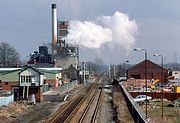 |
Looking east at the site of Tutbury station on 15 March 1989. It's not very often that you see two signal boxes in such close proximity. On the left is Tutbury Yard Signal Box (since demolished), with the Grade II listed Tutbury Crossing Signal Box in the background. The original Tutbury station closed in 1966, but a new station called Tutbury & Hatton opened just three weeks after this picture was taken. Station rebuilding was obviously very quick in the 1980s, as only basic ground clearance for the new staggered platforms is visible in this view. The large Nestlé instant coffee factory dominates the scene. |
|
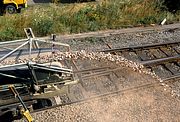 |
The business end of the Redland self-discharge train in action at Uffington on 1 August 1993. Track relaying was in progress, and the train was slowly being propelled backwards along the up line by 37158 & 37092, while ballast was flung onto a plastic membrane that had been laid where the down line would later go. |
|
 |
The Redland self-discharge train deposits new ballast onto a recently laid plastic membrane at Uffington on 1 August 1993, during track relaying operations. 37158 & 37092 are slowly propelling the train backwards, and would luckily soon park in an ideal position for photography. |
|
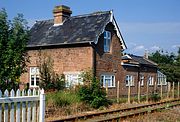 |
Mention Westbury station, and most people would think of the busy junction station in Wiltshire. However, until 1960 there was another Westbury station, on the Shrewsbury to Aberystwyth former Cambrian Railways route. The station was some way from the village of Westbury, and was actually much nearer to a scatter of hamlets on the A58 Shrewsbury to Welshpool road, including Wattlesborough Heath and Halfway House. The station building is now a private residence, and is pictured here on 14 June 2003. |
|
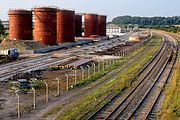 |
Westerleigh Oil Depot, pictured under construction on 22 July 1990. With the newly installed tanks yet to receive their cladding, the rusty metal really stands out in the weak evening sunlight. Just beyond the new office building in the background, is the Avon County Council waste terminal, which had opened a few years earlier, with the commencement of the 'Binliner' rubbish trains to Calvert. The lines on the right, which now end near the M4 motorway, were formerly part of the Midland Railway route to Bath. |
|
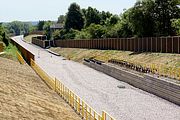 |
During 2016 work progressed steadily on upgrading the former LMS line between Oxford and the newly opened station at Oxford Parkway. This is the view looking south from the recently rebuilt First Turn bridge, near Wolvercote Tunnel, taken on 24 August 2016. Network Rail had originally agreed to lay so called 'silent track' here, in order to cut down on the disturbance that residents either side of the line will experience when this former sleepy single track byway is transformed into a busy mainline. However, they have now reneged on this promise, and are relying instead on the tall fences seen here as noise barriers. In all fairness, there is no such thing as 'silent track', only possibly 'slightly less noisy track', so Network Rail are probably right not to use it. |
|
|
Freshly laid ballast, recently reprofiled cutting sides, and new fences all contribute to a completely different view of Wolvercote Tunnel compared to when the line from Oxford to Bicester was a little used single track byway. This view, taken on 24 August 2016, shows work underway to complete the line between Oxford to Oxford Parkway, forming a new mainline link to London. Behind the trees in the background, unconnected work is also underway on the A40 roundabout. I use the word 'work' loosely, as the improvements are scheduled to take an unbelievable 16 months, and Oxfordshire County Council have quite rightly been criticised for this laughable timescale. I am not the only one to report hardly ever seeing any work going on through the roadworks. |